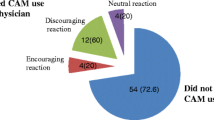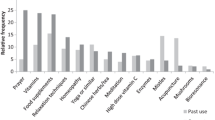Abstract
Goals of the work
The aim of this study was to assess the period prevalence and identify predictors of the use of complementary and alternative medicine (CAM) among women with breast cancer.
Patients and methods
In a cross-sectional study, 263 women participating in a quality of life survey reported on CAM use. Differences between CAM users and nonusers were evaluated using logistic regression.
Results
About 3 years after diagnosis the period prevalence of CAM use among women with breast cancer was 36%. Younger women reported usage of CAM more often than older women. Associations between remote disease, pain and psychosocial variables were found. Involvement in self-help groups and active participation in leisure activities were associated with CAM use; this may indicate differences in the patients’ ability to cope with the disease. Most patients were informed of CAM by a physician.
Conclusions
Involvement in self-help groups and leisure activities were associated with CAM use, indicating differences in the patients’ ability to cope. Further research is necessary to evaluate the safety of CAM and to determine the value of CAM in health care.
Similar content being viewed by others
References
Adler SR, Fosket JR (1999) Disclosing complementary and alternative medicine use in the medical encounter—a qualitative study in women with breast cancer. J Fam Pract 48:453–458
Bloom JR, Stewart SL, Johnston M, Blanks P (1998) Intrusiveness of illness and quality of life on young women with breast cancer. Psychooncology 7:89–100
Boon H, Stewart M, Kennard MA, et al (2000) Use of complementary/alternative medicine by breast cancer survivors in Ontario. Prevalence and perceptions. J Clin Oncol 18:2515–2521
Burstein HJ, Gelber S, Guadagnoli E, et al (1999) Use of alternative medicine by women with early-stage breast cancer. N Engl J Med 340:1733–1739
Cassileth BR (1999) Complementary and alternative cancer medicine. J Clin Oncol 17 (11s):44–52
Crocetti E, Crotti N, Montella M, Musso MI (1996) Complementary medicine and oncologists attitudes. A survey in Italy. Tumori 82:539–542
Downer SM, Cody MM, McCluskey P, et al (1994) Pursuit and practice of complementary therapies by cancer patients receiving conventional treatment. BMJ 309:86–89
Durant JR (1998) Alternative medicine: an attractive nuisance. J Clin Oncol 16:1–2
Eisenberg DM (1997) Advising patients who seek alternative medical therapies. Ann Intern Med 127:61–69
Eisenberg DM, Kessler RC, Forster C, Norlock FE, Calkins DR, Deldano TL (1993) Unconventional medicine in the United States. Prevalence, costs and pattern of use. N Engl J Med 328:246–252
Eisenberg DM, Davis RB, Ettner SL, Appel S, Wilkey S, Van Rompay M, Kessler RC (1998) Trends in alternative medicine use in the United States, 1990–1997: results of a follow-up national survey. JAMA 280:1569–1575
Ernst E, Cassileth BR (1998) The prevalence of complementary/alternative medicine in cancer. A systematic review. Cancer 83:777–782
Ganz PA, Coscarelli A, Fred C, Kahn B, Polinsky M, Petersen L (1996) Breast cancer survivors. Psychosocial concerns and quality of life. Breast Cancer Res Treat 38:183–199
Hosmer DW, Lemeshaw S (2000) Applied logistic regression, 2nd edn. John Wiley & Sons, New York
International Union against Cancer (UICC) (1997) TNM classification of malignant tumours, 5th edn. John Wiley & Sons, New York
Koller M, Heitmann K, Kussmann J, Lorenz W (1999) Symptom reporting in cancer patients II. Relations to social desirability, negative affect and self-reported health behaviors. Cancer 86:1609–1620
Koller M, Lorenz W, Wagner K, Keil A, Trott D, Engenhart-Cabillic R, Nies C (2000) Expectations and quality of life of cancer patients undergoing radiotherapy. J R Soc Med 93:621–628
Lee MM, Lin SS, Wrensch MR, Adler SR, Eisenberg DM (2000) Alternative therapies used by women with breast cancer in four ethnic populations. J Natl Cancer Inst 92:42–47
Lerner IJ, Kennedey BJ (1992) The prevalence of questionable methods of cancer treatments in the United States. Cancer 42:181–191
Moschèn R, Kemmler G, Schweigkofler H, et al (2001) Use of alternative/complementary therapy in breast cancer patients—a psychological perspective. Support Care Cancer 9:267–274
Munstedt K, Kirsch K, Milch W, et al (1996) Unconventional cancer therapy—survey of patients with gynaecological malignancy. Arch Gynecol Obstet 258:81–88
Munstedt K, Entezami A, Wartenberg A, Kullmer U (2000) The attitudes of physicians and oncologists towards unconventional cancer therapies (UCT). Eur J Cancer 36:2090–2095
Nagel G, Schmidt S, Strauss B, Katenkamp D (2001) Quality of life in breast cancer patients. A cluster analytic approach. Empirically derived subgroups of the EORTC-QLQ-BR23—a clinically oriented assessment. Breast Cancer Res Treat 68:75–87
Redler-Hasford E, van Eimern W, Tritschler J (1985) Warum sind Krebspatienten aufgeschlossen für unkonventionelle Behandlungsmethoden? Erfahrungsheilkunde 759–769
Rees RW, Feigel I, Vickers A, Zollmann C, McGurk R, Smith C (2000) Prevalence of complementary therapy use by women with breast cancer. A population-based survey. Eur J Cancer 36:1359–1364
Richardson MA, Sanders T, Palmer JL, Greisinger A, Singletary SE (2000) Complementary/alternative medicine use in a comprehensive cancer center and the implications for oncology. J Clin Oncol 18:2505–2514
Söllner W, Maislinger S, DeVries A, Steixner E, Rumpold G, Lukas P (2000) Use of complementary and alternative medicine by cancer patients is not associated with perceived distress or poor compliance but with active coping behaviour. Cancer 89:873–880
Vickers A (2000) Complementary medicine. BMJ 321:683–686
Weis J, Bartsch H, Hennies F, et al (1998) Complementary medicine in cancer patients. Demands, patient’s attitude and psychological belief. Onkologie 21:144–149
Zollman C, Vickers A (1999) ABC of complementary medicine. Complementary medicine and the doctor. BMJ 319:1558–1561
Acknowledgements
This study was supported by grants from the German Ministry of Health (FB2-43332-70/1). We thank all patients who participated in the survey. We are grateful to our documentation team and thank S. Berg, I. Köhler, B. Osten and K. Polte. The authors also thank S. Schmidt for her helpful comments on the earlier version of this paper.
Author information
Authors and Affiliations
Corresponding author
Rights and permissions
About this article
Cite this article
Nagel, G., Hoyer, H. & Katenkamp, D. Use of complementary and alternative medicine by patients with breast cancer: observations from a health-care survey. Support Care Cancer 12, 789–796 (2004). https://doi.org/10.1007/s00520-004-0675-5
Received:
Accepted:
Published:
Issue Date:
DOI: https://doi.org/10.1007/s00520-004-0675-5




